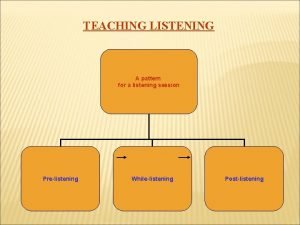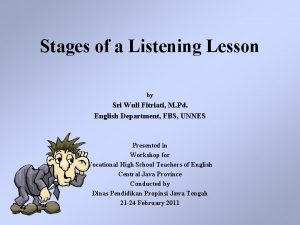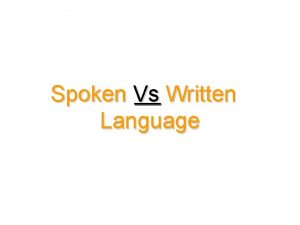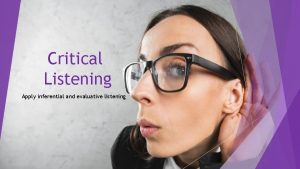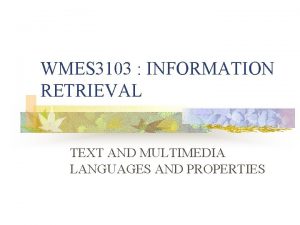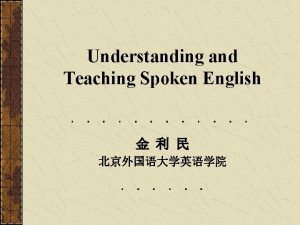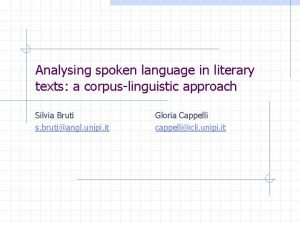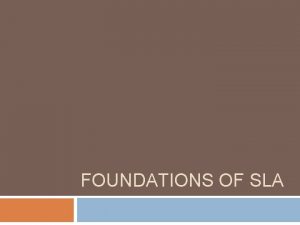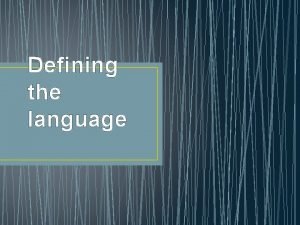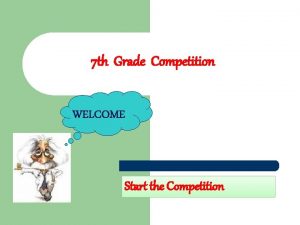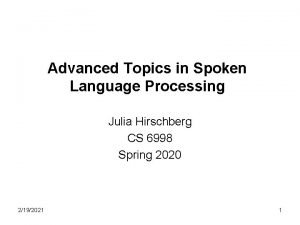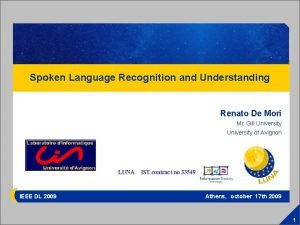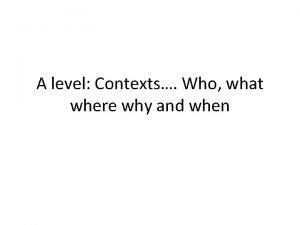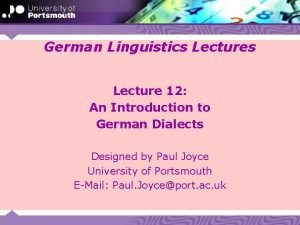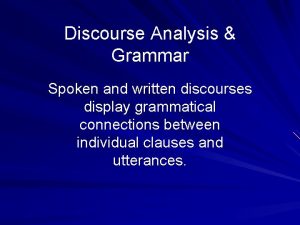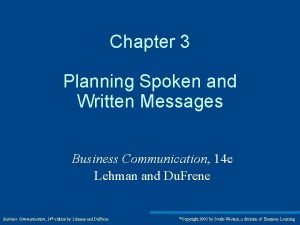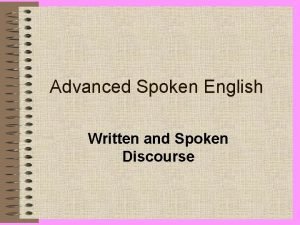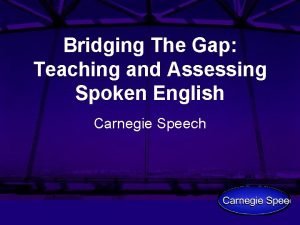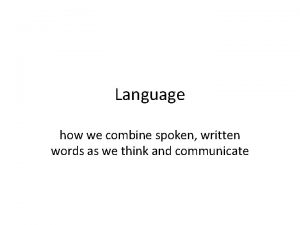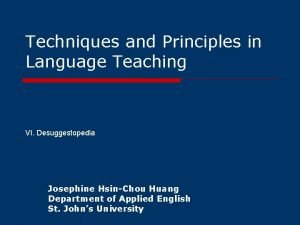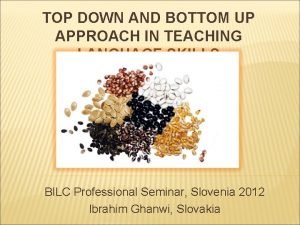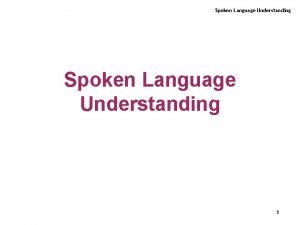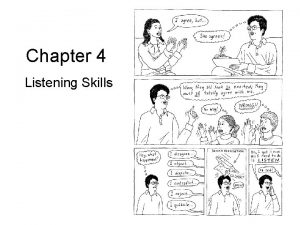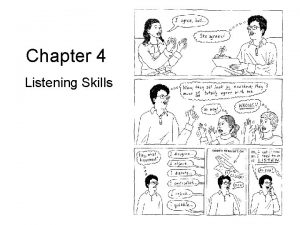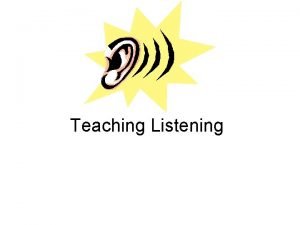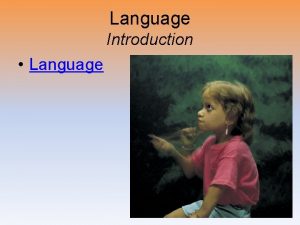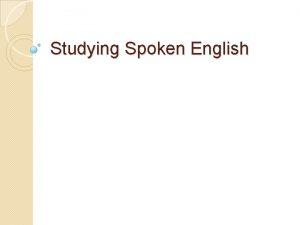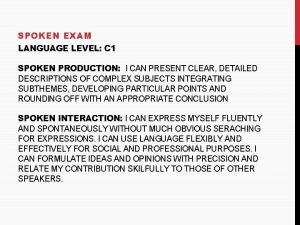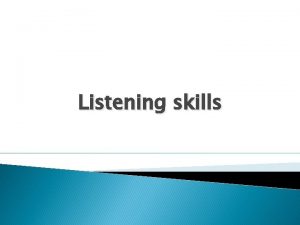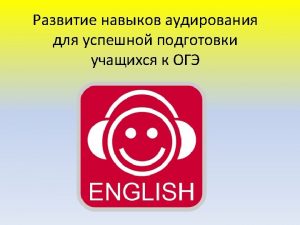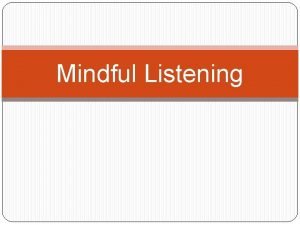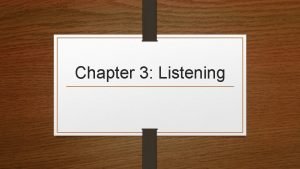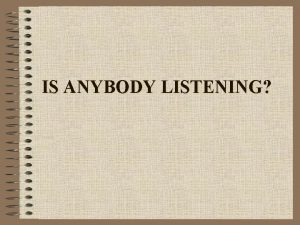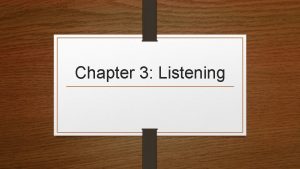An introduction to Teaching Listening Spoken Language and




























- Slides: 28

An introduction to Teaching: Listening, Spoken Language and Literacy

is a sequential multisensory program based on the Association Method. Phonics to Words It teaches: • Listening • Spoken Language • 6 Areas of Reading • Writing • • • to individuals three years and older with the most severe language-learning and literacy problems. This includes students who are: Deaf Hard of Hearing Autistic Brain injured Intellectually disabled Struggling readers

The Association Method The program is based on the Association Method originated by Mildred Mc. Ginnis at the Central Institute for the Deaf in St. Louis, Missouri in the mid-1900 s. CID’s educational program focused on oral deaf education. It was designed specifically for those deaf students who were having extreme difficulty achieving language. Their usual methods involving a natural language or whole-word approach had not resulted in linguistic success for those students. Currently it is used more broadly with a wide range of students with severe language and literacy delays and disorders.

Multisensory Approach The Association Method relies on the principle that students’ will learn language more readily when they are taught using a combination of visual, auditory, tactile, and kinesthetic associations. This approach improves sensory organization skills which are critical to language and literacy acquisition.

Five Modules Scope and sequence 1. Attention getting and imitation skills 2. Phoneme imitation 3. Sound-letter knowledge 4. Auditory and visual discrimination 5. Sound and letter sequencing 6. Word recognition 7. Word building by syllable 8. Development of picture/word association 9. Transition to short sentences 10. Development of concept stories

Language Module 1 Attention getting activities To start… Focus on: Attention, imitation, concentration, precise responses and beginning reciprocity They include: • • Motor Imitation of Drawing Imitation of Tongue Movements Imitation of Noisemaker Sounds

SM i. L E Language Module 1 Goes on to… • Beginning teaching of phonemes — sounds and letters • Consonant-vowel combinations.

Assessment Beginning teaching of phonemes oral, reading, writing, discrimination Step 1 Assess imitation and recognition of 20 letter-sounds and 20 noun-words This provides a baseline. Repeat at intervals to ascertain progress Reassess at end of semester or year Step 2 Teach an initial 10 phonemes using a 6 step process Use a Sound Skills Chart to track progress Step 3 Make books and workbooks for students as they learn each sound. Following are assessment forms for sounds and noun-words



Because books and materials are individually made teachers can adjust them to suit the needs of each student. Print size - -some students see better when print is small, others when it is large. Gradations in size and thickness can be important. Color – Some students see better with black letters on a white background, others yellow on black, or other combinations. Texture - Some benefit from raised letters, others when there is depth. Formatting - The amount of print on a page may need to be varied. Consider space between words and lines Surface angle - A flat or angled surface, dull or shiny background, could make a difference.

Auditory rules to keep in mind When students have difficulty with hearing or comprehension do not speak louder, but use language that is: • SHORT • SIMPLE • SLOW • STIMULUS BOUND Try to work in an environment that is as • DISTRACTION FREE as possible.

Suggested order for first 10 sounds (alternate teaching consonants and vowels) 1. 2. 3. 4. 5. p as in pop o as in top m as in mom ee as in beet b as in bee 6. i-e as in bike 7. f as in feet 8. o-e as in bone 9. t as in toe 10. k as in kite (After first 4 phonemes start CV syllables)

Language Module 2 Step 3 Teachers Next step… Teaching 50 to 60 nouns using a “Six Step Process. The first step is developing a “Cross Drill” that leads to learning words. This is reinforced by saying, reading. writing and associating words with objects and pictures.

Six Steps in Teaching Nouns Step 1 Writing syllable drills leading to a noun (cross drill). Step 2 Writing noun and associate the word with a Step 3 Copying noun while articulating sounds. Student then writes word from memory Step 4 Oral recall: • Picture is shown to student. • Student says noun without sound, written or picture clue Step 5 Writing noun after hearing it spoken, Step 6 Auditory-Visual Discrimination training

Example of “cross drill” leading to a word Left side blank bo bo bee bee bi-e

Circle target word bo bo bee bi-e

Write target word below drill all in one color bo bo bee bi-e bee

Associate word with picture bee

Structured Methods in Language Education Basal Readers Supplement to Language Module 2 /b/ /kc/ /d/ /f/ /g/ /h/ /k/ /m/ /p/ /r/ /s/ /t/

SM i. L E Language Module 3 Expansion of vocabulary: • • Verbs Colors Numbers Plurals

Teaching Verbs At first stick figures are used to clarify that it is the action and not additional features, such as clothing, that is the target word.

Plurals 1 one 2 two bikes dogs

SM i. L E Language Module 4 Goal: To develop the student’s capacity to say, read, write, and understand short sentences and questions that incorporate appropriate grammar and syntax. Sentences include: • pronouns • prepositions • have and has • present progressives • past tense.


SM i. L E Language Module 5 Description stories: • • • Animal Description Stories Inanimate Object Stories Personal Description stories Round-up Stories Experience Stories include questions and answers

Plus (USB drive) Part 1 Support Materials Part 2 SMILE BASAL Readers Farm Family Reading Series Authentic Informational and Narrative Stories Part 3 Auditory and Visual Discrimination Activities My Book of Tools

For further information:
 Post listening stage
Post listening stage Pre listening stage
Pre listening stage It is unplanned less structured and interactive
It is unplanned less structured and interactive Active and passive listening
Active and passive listening What is the purpose of critical listening
What is the purpose of critical listening Spoken language audio retrieval in irs
Spoken language audio retrieval in irs Ting vit
Ting vit Spoken language features
Spoken language features Spoken language features
Spoken language features Most spoken language in the world
Most spoken language in the world Linguistic branch
Linguistic branch Most spoken language in the world
Most spoken language in the world Adv spoken language processing
Adv spoken language processing Renato de mori
Renato de mori Why was french the language spoken in valmonde
Why was french the language spoken in valmonde Comparison between microteaching and traditional teaching
Comparison between microteaching and traditional teaching Top down and bottom up listening
Top down and bottom up listening Spoken english and broken english summary
Spoken english and broken english summary Date romeo and juliet was written
Date romeo and juliet was written Akkudativ
Akkudativ Written and spoken discourse
Written and spoken discourse This can be spoken and written messages
This can be spoken and written messages Written and spoken discourse examples
Written and spoken discourse examples The gap between written and spoken english
The gap between written and spoken english Ciarajuliet_
Ciarajuliet_ Art of combining spoken and written words
Art of combining spoken and written words When you engage in unprocessed note taking, you
When you engage in unprocessed note taking, you Techniques and principles in language teaching
Techniques and principles in language teaching Bottom-up approach in reading
Bottom-up approach in reading
